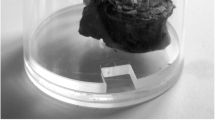Abstract
Objective
For planning surgical interventions at the spine affected by osteoporosis, accurate information about the local bone quality in terms of anchorage strength for implants is very important. Based on previous work on automated bone quality assessment on the proximal femur with a completely automated model-based approach, this paper describes first applications and results on the lumbar vertebrae.
Materials and methods
As basis for the analysis, CT datasets of 17 spinal specimens, with a resolution of 0.7 mm × 0.7 mm × 0.7 mm have been used. A combined statistical model of 3D shape and intensity value distribution was created for these datasets and used to predict the measured bone mineral density (BMD). Different regions of interest were tested, model parameters with high correlation with BMD were identified. Leave-one-out tests were performed to evaluate the capability for the BMD-prediction using regression models.
Results
High correlation values (R = 0.94) between measured and predicted BMD were achieved and the high predictive quality of the model could be shown.
Conclusion
Although the results are only valid for an insufficient small sample size of specimen data, they show a clear potential for clinical application. Therefore, work in the future will focus on clinical validation with larger sample size and the inclusion of biomechanical properties in addition to BMD.
Similar content being viewed by others
References
Fritscher KD, Grünerbl A, Schubert R (2007) 3D image segmentation using combined shape-intensity prior models. Int J Comput Assist Radiol Surg 1(6): 341–350
Fritscher KD, Leber S, Schmoelz W, Schubert R (2008) Level set segmentation of lumbar vertebrae using apperance models, Bildverarbeitung in der Medizin, Algorithmen, Systeme, Anwendungen, BVM 2008, Proceedings. Springer, Berlin, pp 46–50
Fritscher KD, Schuler B, Link T, Eckstein F, Suhm N, Hänni M, Hengg C, Schubert R (2008) Prediction of biomechanical parameters of the proximal femur using statistical appearance models and support vector regression. Med Image Comput Comput Assist Interv (MICCAI), NY 11(1): 568–575
Thirion J-P (1998) Image matching as a diffusion process: an analogy with Maxwell’s demons. Med Image Anal 2: 243–260
Hotelling H (1933) Analysis of complex statistical variables into principal components. J Educ Physiol 24: 417–441
Author information
Authors and Affiliations
Corresponding author
Rights and permissions
About this article
Cite this article
Leber, S., Fritscher, K.D., Schmoelz, W. et al. Statistical model based analysis of bone mineral density of lumbar spine. Int J CARS 4, 239–243 (2009). https://doi.org/10.1007/s11548-009-0287-0
Received:
Accepted:
Published:
Issue Date:
DOI: https://doi.org/10.1007/s11548-009-0287-0




